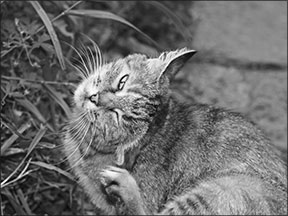Summer brings blooming flowers, singing birds and — biting fleas. Warm weather awakens the fleas, if indeed they were ever asleep. Rising temperatures attributed to global warming are shortening the fleas’ long winter naps and in some areas, eliminating them entirely, making flea bites a year-round risk for cats.

288
Dwight Bowman, M.S, Ph.D., professor of parasitology at Cornell University College of Veterinary Medicine, has a simple explanation for fleas’ abundance: “Each female flea can lay 50 eggs per day onto the host, which includes any warm-blooded animal.”
The Life Cycle. The eggs often roll off onto a cat’s bedding, carpets, couches, blankets and other flea-friendly areas. Their ensuing development depends a good part on this: “The host’s blood, previously consumed by female fleas, provides food in the form of flea dirt for the larvae when they hatch,” Dr. Bowman says.
“The larvae crawl about on the ground or carpet and then fold in half and create a pupal case, a loose, sticky cocoon that may be camouflaged in green, purple or whatever bits of fabric are around them. When they emerge as adults, they immediately jump onto the host that provides them with food, warmth and habitat — everything they need to thrive and repeat that life cycle. An adult flea would never leave an animal if it had a choice.”
While this arrangement may work well for the flea, it will likely make your cat miserable. Flea saliva, the substance deposited into the skin when fleas feed on your cat, contains more than 20 substances that are irritating and potentially allergenic, says dermatologist William H. Miller, VMD, Medical Director at the Cornell University Hospital for Animals.
“The flea’s bite causes a red papule — a small bump sort of like a mosquito bite in a person. If the cat had only one flea, the animal and owner wouldn’t even notice it. However, fleas rarely occur alone. As a group, fleas can inflict numerous itchy bites. And if the animal is allergic to flea saliva, the bite wound is bigger, angrier and itchier,” says Dr. Miller.
Intense Itching. Complications can arise from flea bites when the cat tries to soothe the itching by scratching, licking, chewing or rubbing. Serious scratching — for example, by a cat with sharp claws — can damage the surrounding skin, and that skin can become infected, which can make itching even worse. “In debilitated animals or those with chronic untreated allergies, this secondary infection can seriously damage the skin and cause systemic problems,” Dr. Miller says.
“Fleas are also a vector for tapeworms, as well as various bacterial pathogens like Bartonella, so if a flea is swallowed while the animals licks or chews at its skin, the animal can be infested by tapeworms or myriad systemtic diseases.”
The degree of these reactions and complications in cats depends largely on the severity of the infestation, the degree of allergy in the animal and the timing of the cat’s treatment — ideally promptly. Allergic cats in a heavily infested environment can suffer significant skin damage in a very short period of time. “When a secondary infection is superimposed on a flea-induced rash, health can deteriorate very, very quickly,” Dr. Miller says.
Favorite Sites. Although fleas can bite anywhere on an animal’s body, the nape of the neck and base of the tail are common sites in cats. “If the flea burden is great, it’s easy to see the fleas. With only a few fleas, a flea comb may be necessary to find them,” says Dr. Miller. “The presence of tapeworm segments around the animal’s anus would increase the suspicion of fleas, although particularly in outdoor cats, tapeworm can also result from eating rodents. Any secondary infections would be diagnosed by clinical examination, along with diagnostic samples (cytology) from the lesions. Systemic diseases caused by the transfer of infectious agents might be diagnosed by appropriate blood tests or cultures.”
A few flea bites require no treatment. However, when a cat is uncomfortably itchy due to flea allergies and/or having been bitten by a large number of fleas, veterinarians may prescribe an anti-itch medication. “Primarily, these are steroids, but antihistamines or some newer anti-allergic medications may also be used,” says Dr. Miller.
Product Variety. Anti-flea medications are available in many forms, including topical spot-application products, pump sprays, flea collars and oral medications that require a flea to bite before becoming effective. Some topical products kill fleas by direct contact. Others kill the fleas once they ingest the product. Some products target adult fleas, others target larvae and eggs, and some all three. Still others target fleas as well as other external parasites, such as ticks, lice and mange mites. “Selecting the best product depends upon the area, the cat and the owner’s preference,” says Dr. Miller.
New products to control fleas are constantly being researched and developed. “What began with just lufenuron in 1994 has multiplied,” Dr. Bowman says. “There are 10 to 15 such products out there today. And new products, product combinations and delivery methods are still coming out. We will probably see entirely new chemicals in the next three or four years.”
Although many preventives are available at big box stores, pet stores or farm and garden centers, their staffs may not be knowledgeable about a specific flea-control program for you, Dr. Miller says. “A veterinarian who knows the number and type of animals in your household, the indoor and outdoor environment, and the medical idiosyncrasies of your pets will be able to design the flea-control program best suited to you and your cat.”
Dr. Bowman’s best advice: “Take your cat to the veterinarian for a prescription, follow instructions and don’t stop using flea control in the winter, no matter where you live! Because some pet owners aren’t doing these things, it’s a wormier, more flea-ridden world than it should be.” ❖



